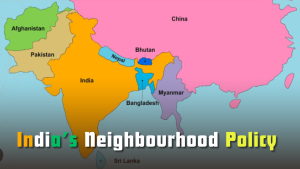Daily Current Affairs 05th July 2025
Welcome to your daily dose of current affairs! In today’s edition, we explore a wide range of crucial topics shaping India and the world—from constitutional values and judicial accountability to public health, environmental challenges, and India’s growing global presence. Here’s a quick look at the major highlights we’ll cover today:
1) Socialism, secularism are the spirit of the Constitution
2) Removal Motion Against Judge
3) India as a Global Chemical Industry Leader
4) BHARAT Study
5) Supreme Court’s Order on Special Police Officers
6) Plastics and Public Health
7) India-Africa Alliance Advances Climate-Resilient Agriculture and Food Security
8) Species in News: Garcinia kusumae
9) India’s TB Elimination Drive
10) SAKSHAM-3000
Socialism, secularism are the spirit of the Constitution
Socialism, Secularism Define the True Spirit of India’s Constitution
Context: Recently, the debate over the words ‘Socialist’ and ‘Secular’ in the Preamble of the Constitution has regained political and legal significance due to renewed calls by the RSS leadership and Vice President Jagdeep Dhankhar to delete these terms, arguing they were undemocratically inserted during the Emergency in 1976.
What are ‘Socialism’ and ‘Secularism’ in the context of the Indian Constitution?
- Socialism in the Indian context refers to social and economic justice, aiming for the eradication of inequality, and creating a welfare state.
Constitutional Provisions
- Socialism: Reflected in Directive Principles – Articles 38, 39, 41, 42, 43.
- Secularism: Embedded in Fundamental Rights –
- Articles 14, 15, 16, 25–28, 29–30.
- It emphasises equality of opportunity and fair distribution of resources without necessarily rejecting private ownership.
- Secularism implies state neutrality in matters of religion. It ensures that the state treats all religions equally, protects minority rights, and prohibits discrimination based on religion.
When and why were these words added to the Preamble?
- The words “Socialist” and “Secular” were inserted into the Preamble through the 42nd Constitutional Amendment Act, 1976, during the Emergency (1975–77) under Prime Minister Indira Gandhi.
- The aim was to explicitly reflect what was already implied in the Constitution’s values—justice, equality, liberty, and fraternity.
- The Supreme Court in S.R. Bommai v. Union of India (1994) upheld that secularism is part of the basic structure, and similarly, social justice—often conflated with socialism—is intrinsic to constitutional governance.
What are the arguments of those who want to remove the word?
- These terms were not part of the original Preamble drafted by the Constituent Assembly.
- The inclusion was politically motivated during the Emergency.
- Socialism, as an ideology advocating state ownership, is seen as obsolete and irrelevant in a liberal market economy.
- Secularism, they claim, is used selectively and has been politically misused.
Why is there resistance to removing these terms?
Where does secularism differ in the Indian vs Western context?
- In the West, secularism often means complete separation of church and state.
- In India, secularism is positive and inclusive, allowing state intervention to reform religion and ensure equality across communities.
For example, Article 25(2)(a) allows the State to regulate secular activities of religious practice.
- These values are woven throughout the Constitution, not limited to the Preamble.
- Secularism is critical in a diverse nation like India to protect religious harmony, minority rights, and constitutional morality.
- Socialism, though debated, is understood in the Indian context as social justice, not Marxist socialism.
- The Supreme Court’s “Basic Structure Doctrine” (Kesavananda Bharati case, 1973) prevents Parliament from amending the core features of the Constitution, which include secularism.
Is there a legal basis to remove ‘secular’ and ‘socialist’ from the Preamble?
- Amendment to the Preamble is possible under Article 368, but cannot violate the basic structure of the Constitution.
- The Supreme Court has repeatedly ruled that secularism is part of the basic structure (e.g., Bommai case, Ismail Faruqui case).
- While the term socialism is debated, social justice and economic equality are clearly part of the basic structure.
Therefore, even if the terms are removed, the underlying principles cannot be taken away.
What is the ideological critique of ‘Socialism’ in today’s India?
- Critics argue that socialism in the original economic sense (state ownership of resources) is irrelevant in the post-1991 liberalised economy.
- They prefer a rights-based, welfare-oriented capitalism that supports free enterprise but also delivers social justice.
- Hence, social justice, not state socialism, is the relevant concept today.
What are the broader implications of removing these words?
- It could signal a shift toward majoritarianism and erosion of minority protections.
- Weakening secularism may deepen social divisions and destabilise India’s pluralistic fabric.
- Diluting socialism may reduce focus on social equity, welfare, and redistribution in policymaking.
- It raises concerns about rewriting constitutional values to align with ideological preferences, undermining constitutional morality.
Removal Motion Against Judge
Justice Yashwant Varma Removal: Impeachment Motion Gains All-Party Momentum
Context: The government is set to begin collecting signatures for a motion to remove Allahabad High Court judge Yashwant Varma, with most major political parties having extended in-principle support to the move.
What Are the Constitutional Provisions for the Removal of Judges in India?
- Article 124(4): A Judge of the Supreme Court can be removed by an order of the President only on the grounds of “proved misbehaviour or incapacity,” following a parliamentary process.
- Article 124(5): Empowers Parliament to regulate the procedure for presenting an address for removal and investigating charges against a judge.
- Article 218: Extends the same provisions to High Court judges, making the process uniform for both Supreme Court and High Court judges.
- Judges (Inquiry) Act, 1968: Provides the statutory framework for investigating allegations and presenting an address for removal.
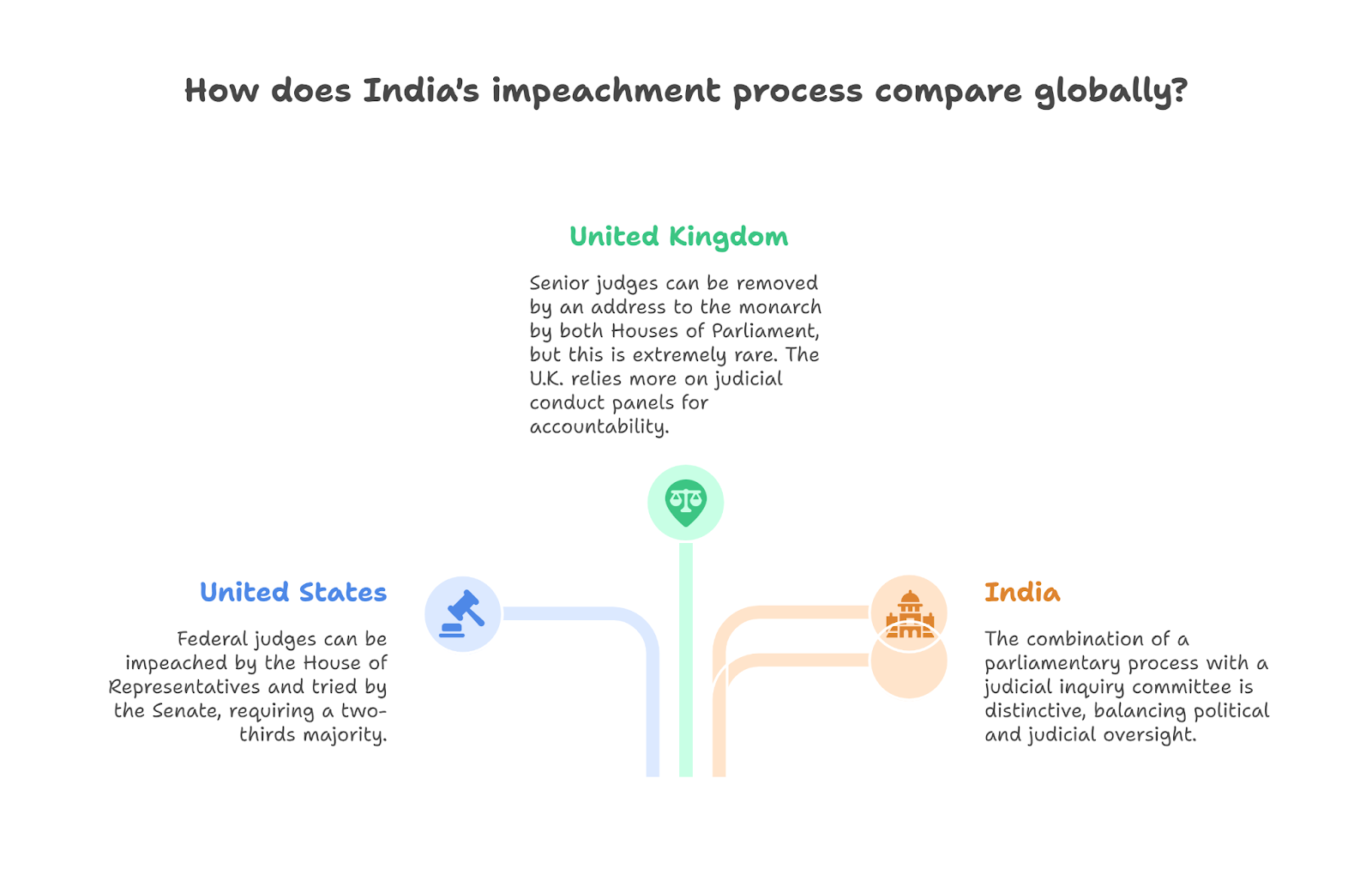
What Are the Grounds for Removal?
- Judges can only be removed on grounds of “proved misbehaviour or incapacity”.
- The Constitution does not define “misbehaviour” or “incapacity,” but judicial interpretations include willful misconduct, corruption, lack of integrity, or medical incapacity.
- The process is often referred to as “impeachment,” though the Constitution does not use this term.
How Is the Removal Process Initiated?
- A removal motion can originate in either House of Parliament:
- At least 100 Lok Sabha members must sign the notice for the Speaker.
- At least 50 Rajya Sabha members must sign the notice for the Chairman.
- The Speaker of the Lok Sabha or Chairman of the Rajya Sabha decides whether to admit the motion. If admitted, it triggers the investigation process.
What Happens After the Motion Is Admitted?
- If admitted, a three-member committee is constituted to investigate the charges. The committee includes:
- A Supreme Court judge,
- A Chief Justice of a High Court,
- A distinguished jurist.
- The committee frames charges and conducts an investigation, allowing the judge to present a written defence.
- If the committee finds the judge not guilty, the motion is dropped. If found guilty, the report is tabled in Parliament.
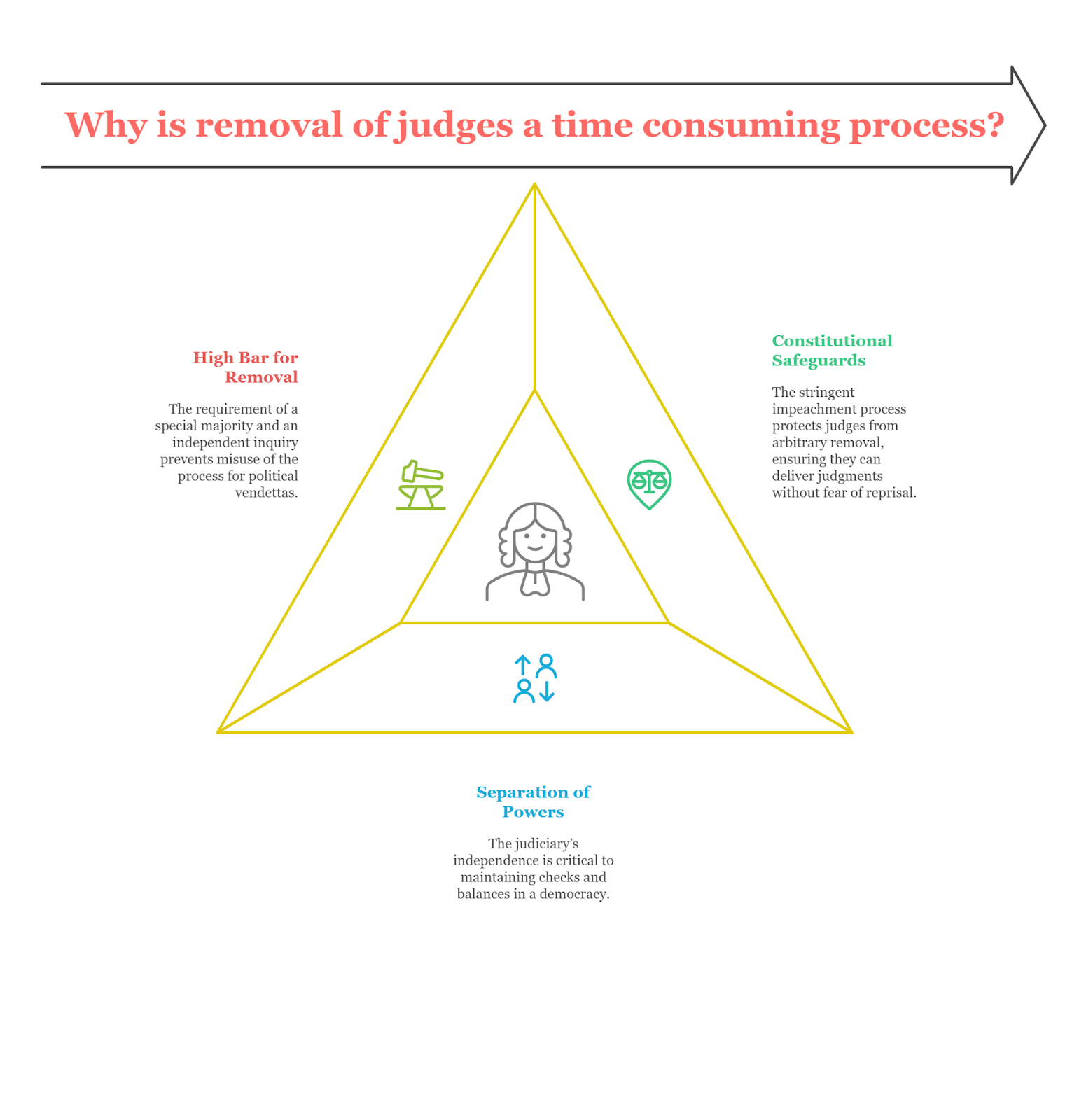
What Is the Parliamentary Procedure for Removal?
- The motion for removal must be adopted by each House of Parliament by:
- A majority of the total membership of that House, and
- A two-thirds majority of members present and voting.
- Both Houses must pass the motion in the same session for it to be valid.
- Once both Houses pass the motion, it is sent to the President, who issues an order for removal.
What Are the Limitations and Loopholes in the Current System?
- If a judge resigns before the completion of proceedings, the investigation typically stops, and the judge retains retirement benefits.
- The Constitution and the Judges (Inquiry) Act, 1968 do not prescribe a specific timeline, leading to potential delays.
- This loophole has been exploited in several cases, allowing judges to avoid full accountability.
India as a Global Chemical Industry Leader
Context: The NITI Aayog’s report, titled “Chemical Industry: Powering India’s Participation in Global Value Chains”, offers a deep dive into the potential and challenges of India’s chemical sector.
More on News
- Although the sector contributes significantly to India’s GDP, it currently holds only a 3.5% share in global chemical value chains (GVCs).
- A trade deficit of USD 31 billion in 2023 further highlights India’s dependence on imported feedstock and specialty chemicals.
- With targeted policy reforms and investments, India has the potential to scale its chemical sector to USD 1 trillion and secure 12% of the global chemical value chain by 2040.
What Are the Main Challenges Facing India’s Chemical Sector?
- Dependence on Imports: A significant lack of backward integration leads to heavy reliance on imported raw materials.
- Infrastructure Deficits: Outdated industrial clusters, poor port infrastructure, and high logistics costs increase production expenses.
- Low R&D Spending: India invests just 0.7% in chemical R&D, far below the global average of 2.3%, limiting innovation in specialty and green chemicals.
- Regulatory Bottlenecks: Delays in environmental clearances slow industrial expansion.
- Skill Shortages: There is a 30% shortfall in skilled professionals, especially in emerging fields like green chemistry, nanotech, and process safety.
Steps Taken by the Government So Far
- Production-Linked Incentive (PLI) Scheme: Extended to advanced chemical cell (ACC) batteries to promote domestic manufacturing.
- PCPIR Policy: Four PCPIRs (Dahej, Visakhapatnam, Paradip, and Cuddalore) developed to attract investments.
- Draft National Chemical Policy (2023): Aims to boost domestic production, reduce imports, and promote sustainability.
- Logistics & Infrastructure Push: PM Gati Shakti and Sagarmala Programme.
- FTA Negotiations: India is negotiating FTAs with EU, UK, and GCC to secure better market access for chemical exports.

What Strategic Interventions Has NITI Aayog Proposed?
- Development of Chemical Hubs: Establish world-class hubs by revamping existing clusters and creating new ones.
- Set up an empowered central committee with a dedicated Chemical Fund for shared infrastructure and Viability Gap Funding (VGF).
- Strengthening Port Infrastructure: Constitute a Chemical Committee for ports to address logistic issues.
- Identify and develop 8 high-potential industrial clusters.
- Launching an Opex Subsidy Scheme: Incentivise incremental chemical production based on criteria like import substitution and export potential.
- Provide time-bound financial incentives on increased sales.
- Enhancing Technology Access and R&D: Foster industry-academia collaboration through an interface agency with DST and DCPC.
- Facilitate technology transfer from multinational companies.
- Reforming Regulatory Clearances: Streamline environmental clearance with an audit committee under DPIIT for monitoring and transparency.
- Empower Expert Appraisal Committees (EACs) with more autonomy.
- Optimising Free Trade Agreements (FTAs): Negotiate chemicals-specific provisions in FTAs, including selective duty exemptions.
- Raise awareness and ease the procedural burden for FTA utilisation by exporters.
- Upgrading Skills and Talent: Expand Industrial Training Institutes (ITIs) and vocational centers.
- Improve faculty quality and update curricula to meet industry demands.
- Promote industry-academia partnerships in specialised areas like polymer science and petrochemicals.
BHARAT Study
Baseline health parameters for the Indian population
Context: Ageing is highly individual. While we all experience it, the rate and nature of ageing vary widely between individuals and across populations.
Why Are Biomarkers Critical in Understanding Ageing?
- The search for biomarkers of ageing — biological indicators that reflect how old the body really is — began in 1935.
- Since then, scientists have tried to find measurable traits that reveal the ageing process and predict responses to diet, lifestyle, and disease.
What Is the BHARAT Study and Why Is It Important?
- In 2023, the Indian Institute of Science (IISc), Bengaluru, launched a nationwide study called BHARAT — short for Biomarkers of Healthy Aging, Resilience, Adversity, and Transitions.
- Part of the Longevity India Program, BHARAT aims to map physiological, molecular, and environmental factors that drive ageing in the Indian population.
Why Doesn’t Living Longer Mean Living Healthier?
- Although life expectancy in India increased by 4.1 years to 67.3 in the early 21st century, longer lives don’t always mean healthier ones.
- A surge in age-related diseases is predicted:
- Parkinson’s disease cases may rise by 168% by 2050.
- Dementia is expected to increase by 200% in low- and middle-income countries.
- Yet, much of our current health knowledge is based on Western studies, making diagnostics, biomarkers, and treatments less applicable to populations in the Global South like India.
What Are the Gaps in Global Biomarkers for the Global South?
- Using Western medical reference values often leads to misdiagnosis in Indian patients. For example:
- Western levels for cholesterol, vitamin D, or B12 may wrongly classify many Indians as deficient.
- CRP (C-reactive protein) levels — a marker of inflammation — are typically higher in Indians even without active illness, often due to early-life infections or chronic stressors.
What Is the Bharat Baseline and How Will It Help?
-
- The BHARAT study aims to create a Bharat Baseline — a population-specific reference range that reflects what’s normal for Indians.
-
This includes:
-
-
- Genomic biomarkers (like disease-linked mutations)
- Proteomic and metabolic indicators (linked to cell functions and energy use)
-
-
Lifestyle and environmental data
- This will enable early detection of organ decline, even before diseases set in.
- For instance, a person’s “liver age” could differ from their actual age — a vital insight for early intervention.
How Is AI Powering India’s Ageing Research?
- Given the complexity of the data, the BHARAT team is leveraging Artificial Intelligence (AI) and machine learning to analyse high-dimensional biological datasets, Simulate health interventions and Predict disease risks and outcomes.
- However, bias in AI models remains a concern. If trained on non-representative data, AI tools may reinforce health inequalities rather than fix them.
Supreme Court’s Order on Special Police Officers
Can the Supreme Court halt an Act passed by a State?
Context: On July 5, 2011, the Supreme Court of India passed a landmark order in Nandini Sundar and Others vs State of Chhattisgarh, directing the State to immediately cease using Special Police Officers (SPOs) for any counter-insurgency activities against Maoists.
About the Ruling
- The Court emphasised that this practice was unconstitutional and violated Article 14 (Right to Equality) and Article 21 (Right to Life and Personal Liberty) of the Constitution.
- The Court also ordered withdrawal of all firearms issued to SPOs and complete cessation of support to groups like Salwa Judum and Koya Commandos.
- The Union Government was also asked to stop funding SPO recruitment for anti-Maoist operations.
Salwa Judum
Salwa Judum (meaning “peace march” in Gondi) was a state-backed militia movement initiated by the Chhattisgarh government in 2005 to counter Maoist activities. It recruited local tribal youth as Special Police Officers (SPOs), providing them with arms and minimal training to assist security forces in anti-Naxal operations. The movement was widely criticised for human rights abuses, including forced displacement, extrajudicial killings, and destruction of villages. In 2011, the Supreme Court of India declared Salwa Judum unconstitutional and illegal, ordering its immediate disbandment, cessation of Union funding for SPOs, and the recovery of all arms and ammunition issued to them.
Why Was a Contempt Petition Filed Against the State of Chhattisgarh?
-
- Following the 2011 Supreme Court order, the Chhattisgarh government enacted the Chhattisgarh Auxiliary Armed Police Forces Act, 2011, which established an auxiliary force to assist regular security forces in combating Maoist violence.
-
Key provisions included:
-
- Auxiliary personnel were not to be deployed in front-line combat.
- Mandatory training of at least six months for recruits.
- SPOs who met the criteria could be screened and inducted into the new force.
- Petitioners alleged that this new law defied the spirit of the 2011 judgment and amounted to contempt of court, claiming that the Act essentially revived SPOs under a new name.
Judicial Review
Judicial review in India is the power of the Supreme Court and High Courts to examine the constitutionality of legislative and executive actions. The power of judicial review is explicitly provided by the Constitution through Articles 13, 32, 131–136, 143, 226, and 246. Article 13 states that any law inconsistent with Fundamental Rights is void;
Articles 32 and 226 empower the Supreme Court and High Courts, respectively, to issue writs for the enforcement of these rights. Since the landmark Kesavananda Bharati case (1973), the Supreme Court has held that Parliament cannot amend the “basic structure” of the Constitution, and any amendment violating this structure can be struck down. Some of the landmark cases include Golaknath v. State of Punjab (1967), Kesavananda Bharati v. State of Kerala (1973), Indira Gandhi v. Raj Narain (1975), Minerva Mills v. Union of India (1980) and I.R. Coelho v. State of Tamil Nadu (2007).
Why Did the Supreme Court Reject the Contempt Allegation?
The Court, however, dismissed the contempt plea, citing several crucial reasons:
- Full Compliance with Court Orders: The State of Chhattisgarh had submitted all required compliance reports and had followed the 2011 directives.
- Legislative Competence: The Court reiterated that State legislatures possess plenary powers to enact laws unless such laws are found to be unconstitutional or beyond their legislative competence.
- Separation of Powers Doctrine: The Court underscored that passing a new law does not amount to contempt, even if it addresses the same issue as a judicial order. As per the doctrine of separation of powers, the judiciary cannot restrict the legislature from enacting laws to address evolving governance challenges.
- The Supreme Court cited its earlier ruling in Indian Aluminium Co. vs State of Kerala (1996), emphasising the need to maintain the constitutional balance among the three sovereign branches—Legislature, Executive, and Judiciary.
What Does This Case Signify for Constitutional Law and Federalism?
- Judicial directions must be respected, but so must the legislature’s power to legislate within constitutional boundaries.
- Any new law passed after a judicial ruling can only be challenged on constitutional grounds, not for being an act of contempt.
India-Africa Alliance Advances Climate-Resilient Agriculture and Food Security
India-Africa partnership for agricultural development and food security
Context: Amid escalating global challenges—rising food insecurity, intensifying climate change, and the pressing need to transform agriculture into a sustainable and resilient sector—the partnership between India and Africa in agriculture and food security has acquired renewed significance.
Why Is the India-Africa Partnership in Agriculture and Food Security Important?
- Both India and Africa face rising challenges such as food insecurity, climate change, and the urgent need for agricultural transformation.
- Agriculture is a backbone for industrialisation and poverty alleviation in Africa, employing nearly 65% of the workforce, yet it contributes only about 15% to the continent’s GDP.
- Africa’s heavy dependence on food imports makes it vulnerable to external shocks, such as the COVID-19 pandemic and the Russia-Ukraine conflict, which have disrupted food supply chains and increased prices.
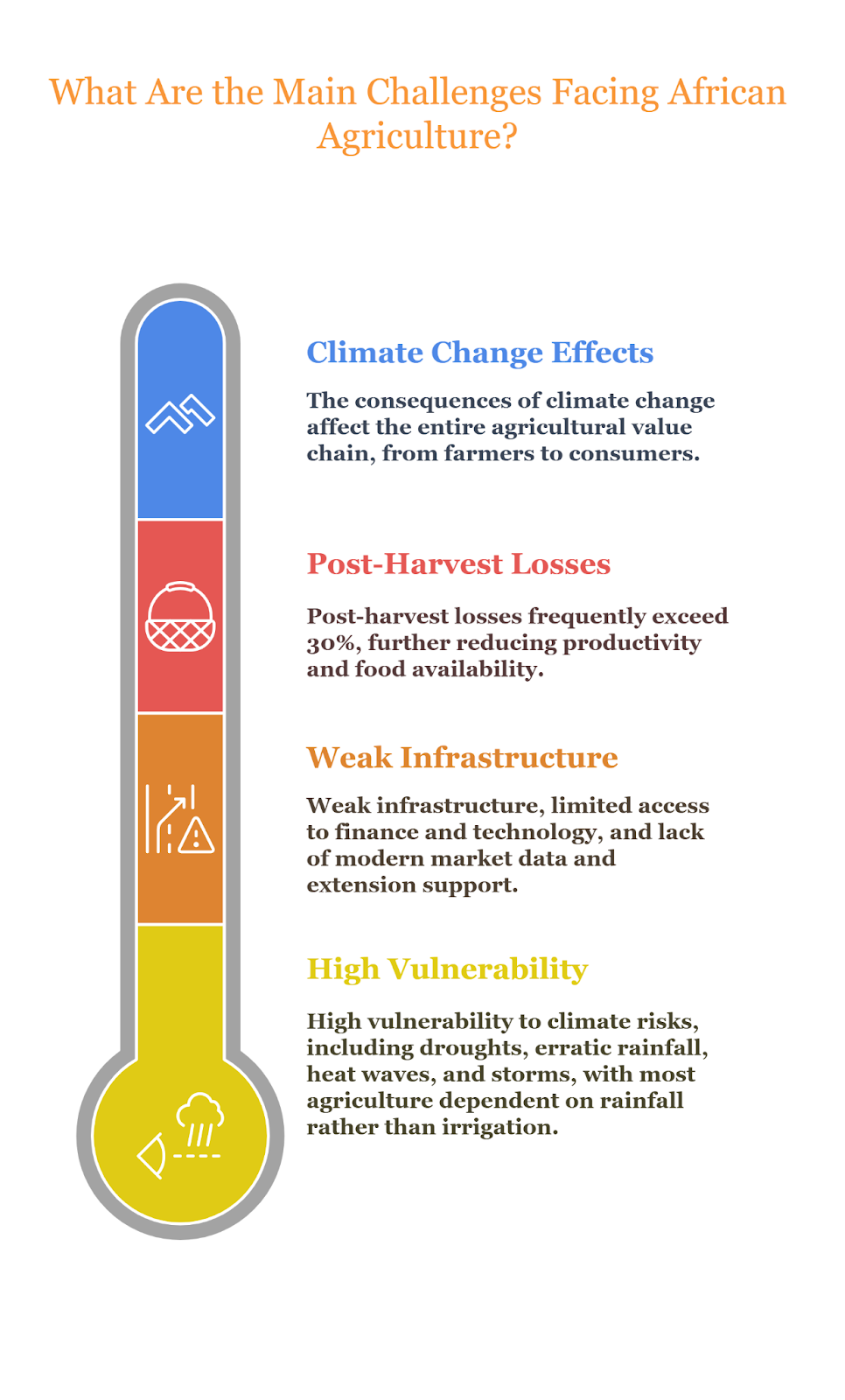
How Are African Institutions Addressing These Challenges?
- The African Union (AU) and African Development Bank (AfDB) have prioritised agricultural development through flagship initiatives:
- Feed Africa Initiative: Aims to transform agriculture into a business, add value to commodities, and lift 320 million people out of hunger.
- Comprehensive Africa Agriculture Development Programme (CAADP): Focuses on hunger elimination, poverty reduction, sustainable land and water management, improved market access, and technology transfer.
How Has India Supported Africa’s Agricultural Transformation?
- India has become a strategic partner, providing:
- Soft loans, training programs, and technology assistance to improve farming practices, irrigation, soil quality, and mechanisation.
- Examples include Angola’s $23 million credit for tractors and machinery, Zimbabwe’s support for rural technology and food testing, and Malawi’s business incubation and training centers.
- Humanitarian assistance includes food aid and equipment donations during crises in countries like Zimbabwe, Malawi, and the Democratic Republic of the Congo.
What Is India’s “3A” Framework and How Does It Benefit Africa?
- The “3A” framework stands for Affordable, Appropriate, and Adaptable technologies.
- It offers scalable, cost-effective solutions tailored to African realities, focusing on:
- Integrating smallholder farmers into modern value chains.
- Reducing post-harvest losses.
- Raising farm incomes through climate-smart practices and value addition.
What Role Do Indian Private Sector and NGOs Play?
- Indian companies have invested in food processing, edible oil production, and beverage bottling across Africa, creating jobs and boosting local economies.
- NGOs like the Self-Employed Women’s Association (SEWA) promote grassroots knowledge exchange and women’s empowerment, adapting successful Indian rural models to African contexts.
How Does Trilateral Cooperation Enhance India-Africa Engagement?
- India collaborates with international agencies (e.g., USAID, UK’s DFID, FAO) for joint projects, such as sending agricultural experts to Lesotho for food security and irrigation planning.
- These partnerships expand the reach and impact of India’s agricultural expertise in Africa.
What Are the Future Opportunities and Requirements for the Partnership?
- Africa’s food market is expected to grow to $1 trillion by 2030, with food demand projected to double by 2050.
- There are significant opportunities for sustainable investment in mechanisation, irrigation, food processing, nutrient management, and agricultural R&D.
- Strengthening the partnership will require:
- Deeper bilateral and trilateral cooperation.
- Expanded private sector involvement.
- Robust knowledge-sharing platforms to ensure food security, inclusive growth, and resilient agri-food systems.
Species in News: Garcinia kusumae
New Garcinia species found in Assam, named after botanist’s mother
Context: A new species of tree, Garcinia kusumae, has been discovered in Assam and described as new to science. The species belongs to the genus Garcinia, locally known as thoikora in Assamese, and was found in the Bamunbari area of Baksa district during a botanical survey.
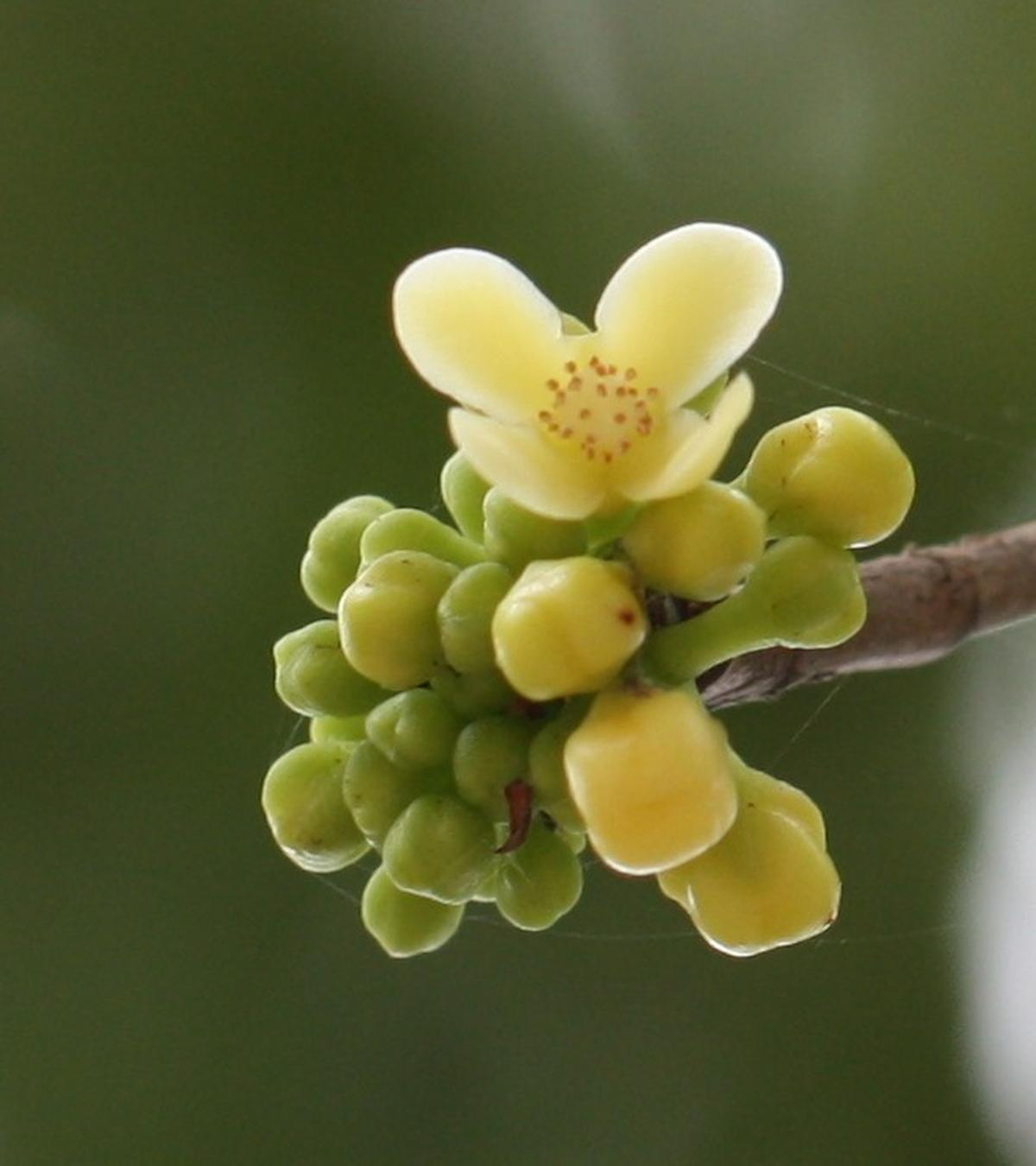
Taxonomy and Nomenclature
- Scientific Name: Garcinia kusumae
- Named After: Kusum Devi, late mother of Jatindra Sarma, a co-author of the study and Chairman of Assam’s State Expert Appraisal Committee under the MoEFCC.
Morphological Features of Garcinia kusumae
- Growth Form: Dioecious, evergreen tree reaching up to 18 meters
- Flowering Period: February to April
- Fruiting Period: May to June
- Distinctive Traits:
- Up to 15 staminate flowers per fascicle
- Fewer stamens per flower (compared to most species except Garcinia assamica)
- Berries with blackish resinous exudations
- Though it shares similarities with Garcinia assamica, G. cowa, and G. succifolia, detailed morphological analysis established its uniqueness.
Genus Garcinia Overview
- Family: Clusiaceae
- Genus Size: 414 species globally
- Distribution: Pan-tropical, with centres of diversity in Africa, Australasia, and Southeast Asia
- Indian Context: 33 species and 7 varieties reported, with Assam accounting for 12 species and 3 varieties
Ecological and Cultural Significance
- Habitat: Found in lowland tropical forests of Assam
- Local Use:
- Fruit Pulp: Sun-dried to make a sherbet (beverage) with salt and sugar; helps prevent heat stroke
- Culinary Use: Added to fish curries
- Traditional Medicine: Used in the treatment of diabetes and dysentery
- Seed Aril: Eaten raw with salt, chilli, and mustard oil — slightly sour and sweet.
Plastics and Public Health
Endocrine disruptors in plastic waste: a new public health threat
Context: Emerging scientific evidence reveals that microplastics and endocrine-disrupting chemicals (EDCs) in plastics are infiltrating human bodies, disrupting hormonal systems, and contributing to chronic diseases.
What Are Endocrine Disrupting Chemicals (EDCs) and How Do They Affect the Body?
- EDCs are chemicals that interfere with the body’s hormone system, disrupting growth, reproduction, metabolism, and mood regulation.
- They mimic or block natural hormones such as estrogen, testosterone, thyroid hormones, and cortisol, leading to altered hormonal signalling.
- Commonly found in plastic products like bottles (Bisphenol A), toys and cosmetics (phthalates), food wrappers (PFAS), and pesticides (dioxins, PCBs).
- Through ingestion of contaminated food, inhalation of polluted air, and skin contact with plastics or cosmetics.
- Even low-level exposure during sensitive periods like pregnancy or puberty can cause lasting harm without immediate symptoms.
How Do Microplastics and EDCs Enter and Accumulate in the Human Body?
- Studies have detected microplastics and EDCs in human blood, lungs, heart, placenta, breast milk, ovaries, and semen.
- In India, 89% of blood samples contained microplastics; men had three times more microplastics in testicular tissue than dogs.
- Microplastics can carry EDCs, facilitating their entry and accumulation in human tissues, posing biological invasion risks beyond environmental pollution.
What Are the Health Impacts of Endocrine Disruptors from Plastic Waste?
- Reproductive Harm: Reduced sperm quality, disrupted menstrual cycles, increased miscarriage risk; EDCs found in semen, placenta, breast milk.
- Hormonal Disruption: Early puberty, thyroid dysfunction, and hormonal imbalances triggered by chemicals like Bisphenol A.
- Cancer Risk: Linked to breast, uterine, testicular, and prostate cancers; many EDCs are classified as probable carcinogens.
- Metabolic Effects: Interference with insulin regulation, promoting obesity and type 2 diabetes; PFAS chemicals linked to liver and heart disease.
- Neurological and Behavioural Effects: Associated with ADHD, learning disabilities, and lower IQ in children, especially with early-life exposure.
- Transgenerational Effects: Changes in gene expression may affect the health of future generations even without direct exposure.
Why Is Plastic Waste a Growing Concern for Public Health?
- Plastic pollution is no longer just an environmental issue but a biological invasion due to microplastics and EDCs infiltrating human bodies.
- The persistence and bioaccumulation of these chemicals in ecosystems and humans amplify their health risks.
- The drop in average sperm count by 30% in India over the past 20 years correlates with rising exposure to plastic-derived EDCs.
- Recent research underscores the urgent need to address plastic waste as a vector for endocrine disruption and related diseases.
What Are the Scientific and Policy Challenges in Addressing EDCs in Plastic Waste?
- Detection and measurement of microplastics and EDCs in human tissues require advanced methodologies.
- Regulatory frameworks lag behind scientific findings on the health risks posed by EDCs.
- Public awareness and policy interventions are needed to reduce plastic use, improve waste management, and limit human exposure.
- Research continues on the epigenetic and developmental impacts of EDCs, emphasising the need for precautionary measures.
India’s TB Elimination Drive
How new technology can help India close in on TB
Context: Prime Minister Narendra Modi recently reviewed the National Tuberculosis Elimination Programme (NTEP), emphasising public participation and the scaling up of innovative strategies. This comes at a crucial time, as advancements in diagnostics, digital tools, and vaccines present new opportunities to detect, treat, and prevent TB more effectively.
The National Tuberculosis Elimination Programme (NTEP) is India’s flagship public health initiative aimed at eliminating tuberculosis by 2025, five years ahead of the global Sustainable Development Goal (SDG) target of 2030.
Key Features of NTEP:
- Vision: A TB-free India with zero deaths, disease, and poverty due to tuberculosis.
- Strategic Pillars: Detect – Treat – Prevent – Build (DTPB)
- National Strategic Plan: 2017–2025, guiding all interventions and innovations
Why is Tuberculosis (TB) Elimination a Priority for India?
- India has made significant progress, with the WHO’s Global TB Report 2024 noting a 17.7% reduction in TB incidence between 2015 and 2023—outperforming the global decline of 8.3%.
- However, challenges remain, particularly in closing the diagnostic gap, which is the weakest link in the TB care cascade.
- Diagnostic Gap: In 2023, an estimated 2.7 million TB cases worldwide went undiagnosed or unreported. Without diagnosis, timely treatment is impossible, allowing transmission to continue.
- A major concern is subclinical TB, where patients show no symptoms. Studies suggest that 50% of TB cases in high-burden countries like India may be subclinical, making them harder to detect through traditional symptom-based screening.
What Are India’s Recent Achievements in TB Detection?
- India’s 100-day intensified TB-Mukt Bharat Abhiyaan provided critical insights: 2.85 lakh asymptomatic TB patients were identified out of 7.19 lakh total cases diagnosed.
- Portable chest X-rays combined with AI-assisted readings helped detect lung abnormalities rapidly. The government now plans to scale up this approach nationwide, setting a potential global model for TB detection.
Successful Interventions and Best Practices
- Community Collaboration: Idukki district in Kerala partnered with Kudumbashree, a women’s self-help group network, for TB elimination. This model demonstrated the power of community participation and leadership advocacy.
- Global Lessons: Vietnam’s use of active case finding for high-risk groups offers a potential model for India, where targeting specific populations with high-risk interventions can improve outcomes.
How Are New Diagnostic Technologies Transforming TB Detection?
- Traditional sputum-based tests can be difficult, especially for children and the elderly. New innovations are changing this:
- Non-invasive sampling (tongue/nasal swabs) enables easier and earlier detection.
- Open PCR platforms reduce testing costs, making molecular diagnostics accessible in public and private healthcare.
- The Indian Council of Medical Research (ICMR) is facilitating the adoption of these tools.
How Can India Reduce TB Mortality?
-
- India has taken key steps to improve supportive care:
- Nikshay Poshan Yojana (NPY) doubled monthly nutritional support (from ₹500 to ₹1,000) to help patients meet dietary needs during treatment.
-
Differentiated TB care models are being introduced, where:
-
- Patients are stratified by risk and severity.
- Severe cases are referred to higher-level facilities.
- Intensive inpatient care is provided where needed.
- These measures can significantly reduce TB deaths, bringing India closer to its goal of near-zero TB mortality.
What Role Will Vaccines Play in TB Elimination?
- An effective TB vaccine is crucial for ending the epidemic.
- India’s success in Covid vaccine development (fast-tracked approvals, global collaboration) can be replicated for TB.
- An mRNA TB vaccine is in early development.
- Other candidates are in clinical trials.
- India’s scientific expertise and manufacturing capacity position it to lead in next-gen TB vaccine deployment.
SAKSHAM-3000
Minister of State for Communications and Rural Development, Dr. Pemmasani Chandra Sekhar, launches high capacity SAKSHAM-3000 switch cum router with 25.6 Tera bit per second throughput today
Context: Dr. Pemmasani Chandra Sekhar, Minister of State for Communications and Rural Development, launched SAKSHAM-3000 at C-DOT Delhi campus.
What is SAKSHAM-3000?
- The SAKSHAM-3000 is a state-of-the-art switch-cum-router designed for high-performance data centres and telecom infrastructure.
- Developed entirely in India by C-DOT, the SAKSHAM-3000 is built to meet the growing demands of cloud computing, AI, 5G/6G networks, and hyperscale data centres.
- This cutting-edge device is designed to power next-generation digital systems and marks a significant step toward realising the AtmaNirbhar Bharat (self-reliant India) vision.
Key Features:
- 25.6 Terabit per second throughput: One of the highest capacities in the industry.
- 32 ports of 400G Ethernet: Supporting speeds from 1G to 400G.
- Ultra-low latency & wire-speed processing: Ideal for AI/ML and real-time applications.
- Modular CROS (C-DOT Router Operating System): Ensuring flexibility and scalability.
- Energy Efficient: Hot-swappable power and fan units, advanced QoS (WRR, WRED)
- Versatile Roles: Functions across leaf, spine, and super-spine nodes in CLOS networks
- Support for Layer-2, IP, MPLS, PTP, and Sync-E: Making it future-ready for legacy and cloud-native networks.
This innovation is a testament to India’s growing capabilities in telecom R&D, reducing dependence on foreign vendors like Nokia, Ericsson, and Huawei.
Subscribe to our Youtube Channel for more Valuable Content – TheStudyias
Download the App to Subscribe to our Courses – Thestudyias
The Source’s Authority and Ownership of the Article is Claimed By THE STUDY IAS BY MANIKANT SINGH

